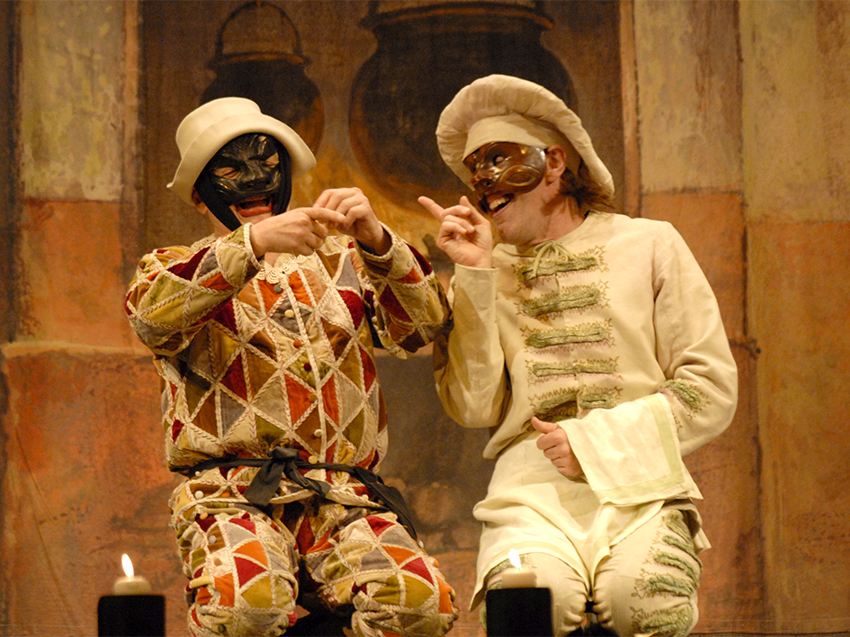Scan barcode
A review by saareman
The Servant of Two Masters by Louise Dorothy, Carlo Goldoni, Dorothy Louise
4.0
A Very Modern Day Adaptation
Review of the Ivan R. Dee paperback edition (June 7, 2003) translated and adapted by [a:Dorothy Louise|3937116|Dorothy Louise|https://s.gr-assets.com/assets/nophoto/user/u_50x66-632230dc9882b4352d753eedf9396530.png] from the Italian language original [b:Il Servitore Di Due Padroni|233899|Il Servitore Di Due Padroni|Carlo Goldoni|https://i.gr-assets.com/images/S/compressed.photo.goodreads.com/books/1450312503l/233899._SY75_.jpg|1014537] (1745).

The servant of two masters Truffaldino (left, in a traditional harlequin costume) discusses meals with the innkeeper/restauranteur character Brighella (right, wearing a chef's hat). Image sourced from Uanema.net.
After seeing and reading Richard Bean's [b:One Man, Two Guvnors|11066944|One Man, Two Guvnors|Richard Bean|https://i.gr-assets.com/images/S/compressed.photo.goodreads.com/books/1328705967l/11066944._SY75_.jpg|15988237] (2011) recently at Canada's Shaw Festival 2024 i was curious to read the original work on which it was based. Dorothy Louise's adaptation was the easiest to find, but as with most of the contemporary English language versions which I noticed it is not a direct translation but instead adopts very 20th/21st century references in an effort to make it more comprehensible to a modern day audience. It just seems anachronistic to have characters named Truffaldino and Smeraldina spouting dialogue which mentions modern day phenomena.
Still, Dorothy Louise does capture the manic energy and drive which is also present in Bean's version so it must all derive from the original Italian. The plots and subplots are similar in all of them: a hungry servant agrees to work for two masters who happen to be estranged lovers (one being a female impersonating her dead brother). The servant manages to mix up letters from the post office, meals at a restaurant, keepsakes found in trunks & suitcases, money exchanged as dowry, etc. But all works out in the end and the lovers are reunited and the servant themself finds love as well. Happy endings all around.
Trivia and Link
There is an early English language translation from 1928 which is more faithful to the original and which you can read at Project Gutenberg here.
There is a filmed performance of an Italian language version on YouTube which you can watch here. This is much closer to the original Commedia dell'Arte style, including the use of face masks. You can watch it in the language of your choice by turning on subtitles and then auto-translate and then selecting your preferred language.
Review of the Ivan R. Dee paperback edition (June 7, 2003) translated and adapted by [a:Dorothy Louise|3937116|Dorothy Louise|https://s.gr-assets.com/assets/nophoto/user/u_50x66-632230dc9882b4352d753eedf9396530.png] from the Italian language original [b:Il Servitore Di Due Padroni|233899|Il Servitore Di Due Padroni|Carlo Goldoni|https://i.gr-assets.com/images/S/compressed.photo.goodreads.com/books/1450312503l/233899._SY75_.jpg|1014537] (1745).
Truffaldino: In fact, I've got a theory about all those serial killers who've lost their jobs at the post office and come back one morning and blast the place to kingdom come. First, they're in Valium withdrawal, they're not responsible. And second --

The servant of two masters Truffaldino (left, in a traditional harlequin costume) discusses meals with the innkeeper/restauranteur character Brighella (right, wearing a chef's hat). Image sourced from Uanema.net.
After seeing and reading Richard Bean's [b:One Man, Two Guvnors|11066944|One Man, Two Guvnors|Richard Bean|https://i.gr-assets.com/images/S/compressed.photo.goodreads.com/books/1328705967l/11066944._SY75_.jpg|15988237] (2011) recently at Canada's Shaw Festival 2024 i was curious to read the original work on which it was based. Dorothy Louise's adaptation was the easiest to find, but as with most of the contemporary English language versions which I noticed it is not a direct translation but instead adopts very 20th/21st century references in an effort to make it more comprehensible to a modern day audience. It just seems anachronistic to have characters named Truffaldino and Smeraldina spouting dialogue which mentions modern day phenomena.
Still, Dorothy Louise does capture the manic energy and drive which is also present in Bean's version so it must all derive from the original Italian. The plots and subplots are similar in all of them: a hungry servant agrees to work for two masters who happen to be estranged lovers (one being a female impersonating her dead brother). The servant manages to mix up letters from the post office, meals at a restaurant, keepsakes found in trunks & suitcases, money exchanged as dowry, etc. But all works out in the end and the lovers are reunited and the servant themself finds love as well. Happy endings all around.
Trivia and Link
There is an early English language translation from 1928 which is more faithful to the original and which you can read at Project Gutenberg here.
There is a filmed performance of an Italian language version on YouTube which you can watch here. This is much closer to the original Commedia dell'Arte style, including the use of face masks. You can watch it in the language of your choice by turning on subtitles and then auto-translate and then selecting your preferred language.